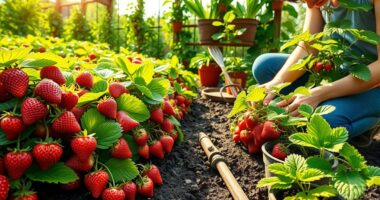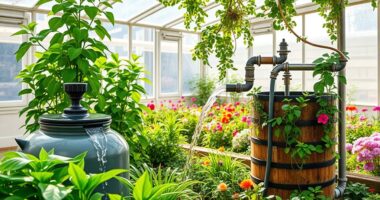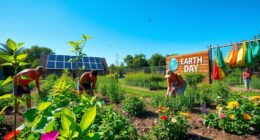To guarantee a thriving garden in 2025, I focus on key soil management practices. I analyze soil types and regularly test pH levels for nutrient availability. Incorporating organic matter enriches my soil, while moisture retention techniques, like mulching and cover cropping, keep plants hydrated. Erosion control methods, like contour farming, protect soil integrity. I've found that managing compaction and promoting a healthy ecosystem makes all the difference. Stick around, and you'll discover even more strategies to enhance your garden!
Key Takeaways
- Regularly test soil every 1-3 years to monitor nutrient levels and pH, ensuring optimal conditions for plant growth.
- Incorporate organic matter like compost to enhance soil structure, fertility, and moisture retention for healthier plants.
- Utilize cover crops in the off-season to prevent erosion, improve soil health, and enrich nutrients for future planting.
- Practice no-till farming to maintain soil structure, reduce compaction, and enhance moisture retention, benefiting plant health.
- Implement erosion control techniques such as contour farming and mulching to protect soil integrity and promote sustainable gardening practices.
Soil Science and Management

If you're an above-average gardener enthusiastic to elevate your planting game, "Soil Management Practices for a Thriving Garden" is your go-to resource. This book dives deep into soil science and management, making complex concepts accessible. I found the structure easy to navigate, with vibrant photos that enhance understanding. Although some practice problems could be clearer, the foundational knowledge offered is invaluable. At $180, it's a significant investment, yet it's worth every penny for its rich insights. Whether you're a home gardener or a professional, this textbook is essential for mastering soil dynamics and improving your garden's health.
Best For: Above-average gardeners and professionals seeking to deepen their understanding of soil science and improve garden health.
Pros:
- Well-structured with ample white space and vibrant photographs that enhance readability.
- Provides foundational knowledge and practical examples, making complex concepts accessible.
- Considered a valuable investment for its rich scientific information and insights into soil dynamics.
Cons:
- High price point at $180 for a used copy may deter some potential buyers.
- Some practice problems are vaguely worded, which may lead to confusion.
- May not serve as an everyday reference for casual gardeners.
Soil Science & Management

For anyone enthusiastic to cultivate a thriving garden, understanding soil science and management is essential. I've found that knowing the quality of your soil can greatly impact your plants' health. Unfortunately, some resources I've encountered, like an unauthorized book variant, lacked vibrant color visuals, making it tough to grasp essential diagrams. While classmates had similar issues, the cheaper price made it somewhat valuable for our studies. However, I'd recommend seeking out licensed editions for the best learning experience. Ultimately, effective soil management hinges on quality information, so prioritize finding reliable sources to enrich your gardening knowledge.
Best For: Students seeking a budget-friendly resource for soil science and management studies.
Pros:
- Quick delivery of the book.
- Cost-effective option compared to licensed editions.
- Provides satisfactory content for class use despite quality issues.
Cons:
- Unauthorized version with quality concerns, including smudged text.
- Black and white visuals that make understanding diagrams difficult.
- Limited circulation rights, raising concerns about legality and authenticity.
Soil Science For Beginners: A Guide to Regenerative Agriculture
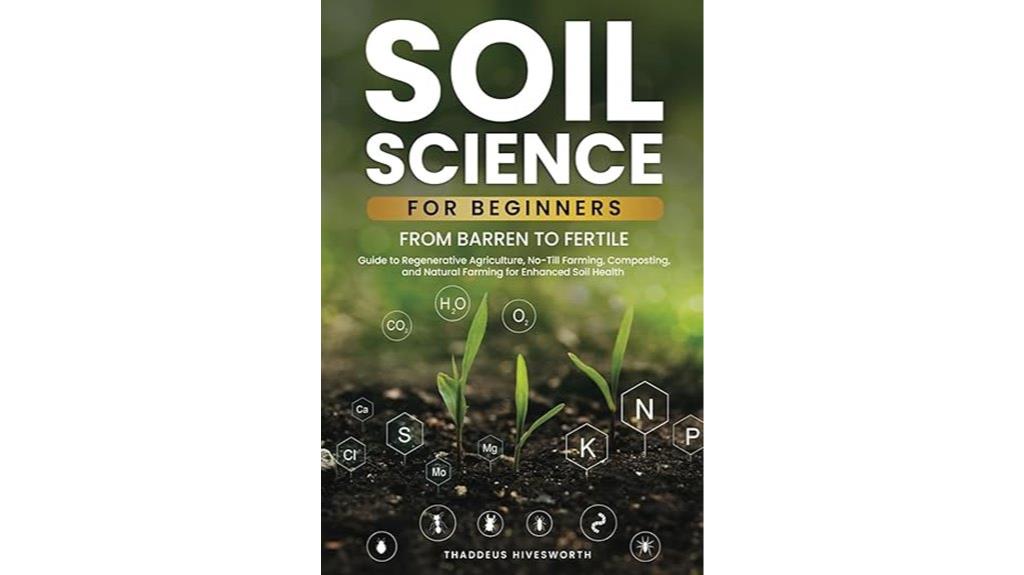
Understanding soil science is essential for anyone keen to cultivate a thriving garden, whether you're a novice or an experienced gardener. I've found that healthy soil is the foundation for robust plant growth, and regenerative agriculture practices are key. The book I recommend highlights soil health, focusing on no-till farming and composting. It's packed with practical insights on soil types and amendments that can rejuvenate your garden. Plus, its clear structure makes it accessible for all levels. By embracing these practices, we can combat climate change and secure food for the future, ensuring our gardens flourish sustainably.
Best For: Individuals looking to enhance their gardening skills and understand soil science, from beginners to experienced gardeners.
Pros:
- Educational Resource: Provides comprehensive insights into soil science, helping readers correct misconceptions about soil and plant nutrition.
- Practical Guidance: Offers actionable advice on managing soil types, amendments, and regenerative practices, suitable for sustainable gardening.
- Accessible Structure: Well-organized content makes it easy to understand, ideal for homeschooling and for readers of all experience levels.
Cons:
- Limited Focus on Conventional Practices: Some readers may find the emphasis on regenerative and organic practices lacking in information regarding standard agricultural methods.
- Potentially Overwhelming for Beginners: Newcomers might feel overwhelmed by the depth of information presented.
- Less Emphasis on Large-Scale Operations: The content may not fully address the needs of those interested in large-scale agricultural practices.
Organic Soil-Fertility and Weed Management Handbook

New farmers and growers looking to build a sustainable garden will find the "Organic Soil-Fertility and Weed Management Handbook" invaluable. This thorough resource serves as a solid foundation for understanding organic soil fertility and weed management. I appreciated its informative content, which covers essential topics, including various weed species, although it doesn't investigate every detail. The book arrived in great condition, reflecting reliable delivery and quality. Plus, it includes references for further exploration, enhancing my knowledge beyond its pages. Overall, it's a fantastic starting point for anyone enthusiastic to cultivate a thriving organic garden.
Best For: New farmers and growers seeking a foundational understanding of organic soil fertility and weed management.
Pros:
- Provides a comprehensive overview of essential topics related to organic gardening.
- Arrives in good condition, ensuring quality and reliable delivery.
- Includes references for further study, allowing readers to expand their knowledge.
Cons:
- May exhibit some bias and lack thoroughness in certain areas.
- Does not cover every detail regarding weed species, which might limit understanding.
- Primarily targeted at beginners, potentially lacking depth for more experienced growers.
Introduction to Soil Science: Sustainable Agriculture
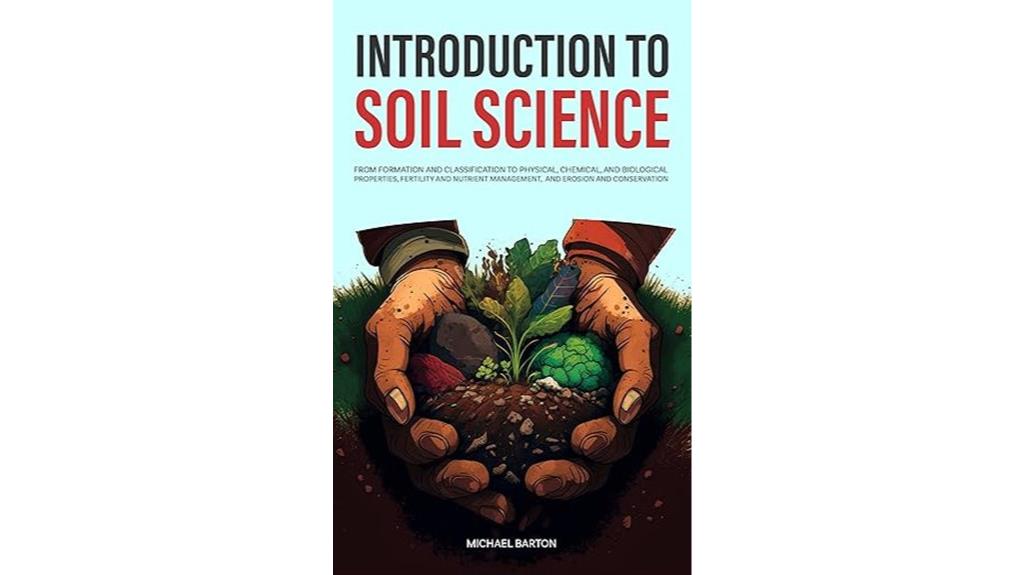
Gardening enthusiasts seeking to create vibrant and productive gardens will find "Soil Management Practices for a Thriving Garden" an invaluable resource. Michael Barton's "Introduction to Soil Science" teaches us how soil health and fertility are essential for thriving plants. It covers everything from soil formation to nutrient management, making it accessible for both beginners and experienced gardeners. I appreciate the focus on sustainable practices and conservation tips, especially in today's world where environmental challenges are pressing. While it has some limitations, it lays a solid foundation, encouraging us to dive deeper into the fascinating world of soil science for better gardening outcomes.
Best For: Beginners in gardening and agriculture looking for foundational knowledge in soil science and sustainable practices.
Pros:
- Engaging and accessible content, suitable for readers with varying levels of experience.
- Emphasis on sustainable practices and soil conservation, addressing current environmental challenges.
- Provides a comprehensive overview of soil health and fertility, essential for successful gardening.
Cons:
- Some readers find the content repetitive and lacking in depth.
- Limited practical guidance on specific soil improvement techniques and measurements.
- Omissions of advanced topics and notable soil scientists may leave some readers wanting more detailed information.
Improving Your Soil: A Practical Guide to Soil Management for Home Gardeners

For serious home gardeners looking to enhance their soil, "Improving Your Soil" stands out as an invaluable resource. This practical guide simplifies complex soil science, making it accessible and engaging. Whether you're into organic or traditional practices, it offers practical techniques tailored to your unique soil type. You'll find insights that go beyond the usual cover crops and compost advice, helping you develop independent solutions. I've appreciated the illustrations that clarify concepts, and the positive feedback from fellow gardeners reinforces its value. If you're enthusiastic to create a thriving garden, this guide is a must-read for your soil management journey.
Best For: Serious home gardeners interested in enhancing their soil management skills, whether practicing organic or traditional farming.
Pros:
- Comprehensive and accessible explanations of complex soil science concepts.
- Offers practical techniques tailored to individual soil types, going beyond basic advice.
- Engaging writing style with great illustrations that enhance understanding.
Cons:
- Some readers may find limited information on very small plots or specific conditions.
- A basic understanding of chemistry could be beneficial for full comprehension.
- Primarily targeted at Canadian audiences, which may limit relevance for others.
100064312 JCD-030SM 3-Pound Granules, White

If you're looking to simplify your plant care routine while ensuring your indoor and outdoor plants thrive, the 064312 JCD-030SM 3-Pound Granules, White are an ideal choice. These eco-safe, water-storing polymers reduce your watering needs by 50%, making them perfect for container gardening. I poke holes in the soil around my plants and add the granules for maximum moisture retention, especially during hot weather. Users, including myself, have noticed healthier plants that require less frequent watering—up to 10 days longer! For anyone wanting to enhance hydration efficiency, these granules are a must-have for thriving plants.
Best For: Those looking to simplify plant care and improve hydration efficiency for indoor and outdoor container gardening.
Pros:
- Reduces watering needs by 50%, saving time and effort.
- Maintains moisture for up to 10 days, especially beneficial during hot weather.
- Eco-safe polymers enhance plant health and hydration.
Cons:
- Overuse can lead to excess granules on the soil surface.
- Requires proper application to avoid ineffective results.
- Some users may find the initial cost higher compared to traditional watering methods.
EarthScout 5-in-1 Soil Moisture Meter

The EarthScout 5-in-1 Soil Moisture Meter stands out as an essential tool for anyone serious about optimizing their garden's health. This meter measures soil moisture, temperature, electroconductivity, and even air conditions, making it incredibly versatile. I love how easy it is to use; just insert the sensor and tap the screen for instant readings. Plus, its durable, waterproof design means it can handle outdoor conditions without a hitch. With American-made reliability and a reference chart for soil types, I feel confident in my gardening decisions. It's definitely a worthy investment for a thriving garden.
Best For: Gardeners, farmers, and landscaping professionals looking for a reliable tool to monitor soil and air conditions effectively.
Pros:
- Easy to use with instant readings for multiple measurements.
- Durable and waterproof design suitable for outdoor use.
- American-made product with a 1-year warranty for added peace of mind.
Cons:
- Requires 6 AA batteries, which may need frequent replacement.
- Heavier than some other soil moisture meters on the market.
- Best Sellers Rank indicates it may not be as popular as competing products.
Soil Science & Management

Soil Management Practices for a Thriving Garden stands out as an invaluable resource for farmers and backyard gardeners alike, especially those just starting their journey in soil science. This accessible book offers practical insights that help me navigate soil and crop management effectively. Surprisingly engaging for a textbook, it's perfect for high school readers, not just seasoned scientists. I found it in excellent condition, just as described, and at a great price. If you're enthusiastic to deepen your understanding of soil dynamics, I highly recommend checking it out. It's an essential reference for anyone passionate about soil and plant nutrition.
Best For: This book is best for new farmers and backyard gardeners looking to enhance their understanding of soil science and management.
Pros:
- Offers practical and useful information for effective soil and crop management.
- Written in an engaging and accessible manner, suitable for high school readers.
- Excellent condition and great pricing make it a valuable resource.
Cons:
- May not provide in-depth information for experienced soil scientists.
- Focuses primarily on basic soil science, potentially limiting for advanced studies.
- Targeted towards beginners, which might not meet the needs of all agricultural professionals.
Soil and Water Management Systems
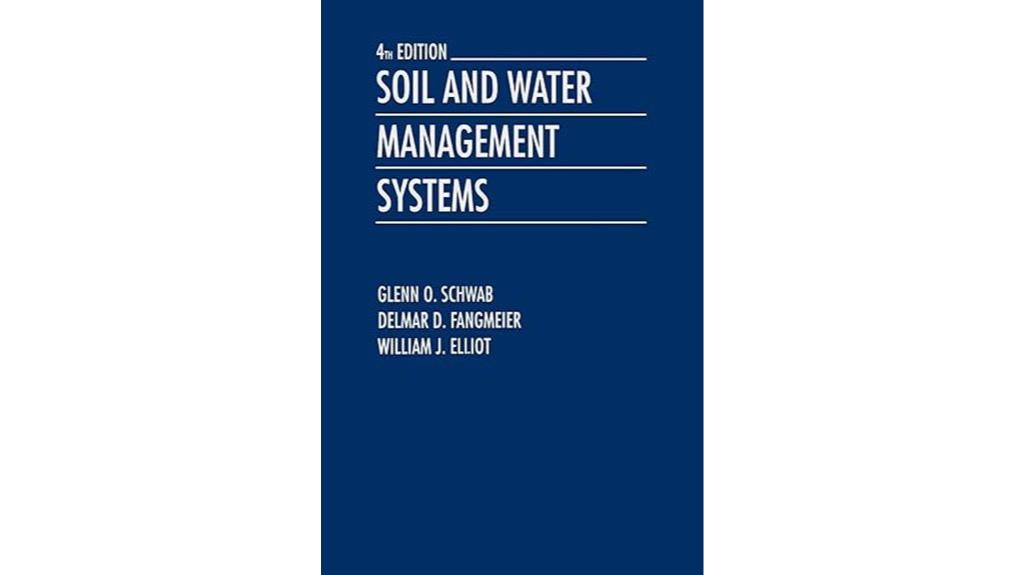
For anyone looking to enhance their gardening efforts, understanding soil and water management systems is essential. I found a helpful book on this topic during my college course at North Carolina State University. It simplifies complex concepts, making water management practices easier to grasp. However, I noticed it lacks detailed explanations for mathematical equations, which can be frustrating when solving scenarios like water runoff rates. Despite a mix-up with my order, I still gained valuable insights. If you're serious about improving your garden, this knowledge will be vital for sustainable success in 2025 and beyond.
Best For: Individuals seeking to improve their gardening skills and understand water management practices for sustainable success.
Pros:
- Easy to understand, making it accessible to a wide audience.
- Contains good concepts that aid in the comprehension of water management intricacies.
- Provides valuable insights for effective gardening.
Cons:
- Lacks sufficient information on mathematical equations for practical applications.
- Does not adequately explain necessary steps to solve water management scenarios.
- Some users may experience issues with incorrect book delivery.
Factors to Consider When Choosing Soil Management

When I think about choosing the right soil management practices, I consider several key factors. Analyzing soil type and evaluating nutrient content are essential steps that can make or break my garden's success. I also can't overlook the importance of organic matter, moisture retention techniques, and erosion control strategies in creating a thriving environment for my plants.
Soil Type Analysis
Understanding soil type analysis is essential for successful gardening, as it directly influences how well your plants grow. I've learned that analyzing soil texture, structure, and composition is vital. The major textures—sand, silt, and clay—impact moisture retention and nutrient availability. For instance, sandy soils drain fast but lack nutrients, while clay soils retain moisture but can struggle with drainage. Checking soil pH is equally important; most plants thrive in a pH of 6.0 to 7.5. Conducting a soil test gives me insights into nutrient levels and organic matter, guiding my management practices. Finally, identifying soil compaction helps me implement strategies for better aeration and water infiltration, ensuring my garden flourishes.
Nutrient Content Assessment
Evaluating nutrient content in soil is an important step for any gardener aiming for a thriving garden. I focus on key elements like nitrogen, phosphorus, and potassium, which are essential for plant growth. Using reliable soil tests, I can measure these nutrients effectively. I also pay attention to soil pH since it influences nutrient availability; I've found that a pH of 6.0 to 7.0 is ideal. Additionally, I consider micronutrients such as iron, manganese, and zinc, which are critical for plant health. Regular soil testing every 2-3 years helps me track nutrient levels and adjust my soil management practices accordingly. This proactive approach guarantees my garden remains fertile and productive over time.
Organic Matter Inclusion
Incorporating organic matter into my garden soil is crucial for building a thriving ecosystem, as it not only enhances soil structure but also boosts its fertility. It improves aeration and water retention, which are essential for healthy root development. Plus, organic matter serves as food for soil microorganisms, promoting biodiversity and vital nutrient cycling for my plants. By adding organic matter, I can increase soil fertility, supplying important nutrients like nitrogen, phosphorus, and potassium in a slow-release form. It also helps buffer soil pH, creating a stable environment for both plants and microorganisms. Regularly adding organic matter greatly improves soil health, leading to increased crop yields and resilience against pests and diseases, ensuring my garden flourishes.
Moisture Retention Techniques
Moisture retention techniques are essential for keeping my garden thriving, especially during dry spells. By incorporating organic matter like compost or mulch, I can improve the soil's structure and enhance its water-holding capacity. This creates a sponge-like effect that helps retain moisture. I also grow cover crops in the off-season; they not only prevent erosion but also improve soil texture and reduce evaporation. Additionally, I use water-retaining polymers that absorb water and release it gradually, extending the time between watering. Practicing no-till farming is another strategy I employ, as it helps maintain soil structure and moisture levels, allowing for better water infiltration and retention. These techniques greatly reduce my irrigation frequency and conserve precious water resources.
Erosion Control Strategies
While considering soil management, I find that erosion control strategies are essential for maintaining a healthy garden. One effective method is contour farming, which follows the land's natural contours to reduce water runoff and improve absorption. I also plant cover crops like legumes and grasses; they protect the soil surface, reduce erosion, and enhance soil structure as they decompose. Terracing is another strategy I use, shaping my garden into steps to slow water movement on slopes. Installing silt fences or sediment traps captures sediment, preventing it from entering water bodies. Finally, I mulch with organic materials like straw, which shields the soil from erosion and retains moisture while enriching it as it breaks down.
Ph Level Management
Erosion control strategies have laid a strong foundation for my garden's health, but managing soil pH is just as important for promoting plant growth. The pH level of my soil directly affects nutrient availability; I aim for a range between 6.0 and 7.5, where nutrients like nitrogen, phosphorus, and potassium thrive. I regularly test my soil, ideally every 1-3 years, since fluctuations can occur from rainfall and amendments. I've learned that a more acidic pH can harm beneficial microbes, which are essential for nutrient cycling. To adjust pH, I use lime to raise it or sulfur to lower it. It's crucial to assess pH variability across my garden, ensuring I apply the right amendments where needed.
Frequently Asked Questions
How Often Should I Test My Garden Soil?
I usually test my garden soil at least once a year. It helps me understand its nutrient levels and pH balance, ensuring my plants get what they need to thrive. If I'm growing something new or making significant changes, I'll test more often. Keeping an eye on soil health has really improved my garden's productivity and liveliness, so I recommend you make it a regular part of your gardening routine, too!
What Is the Ideal Ph Level for Most Garden Plants?
The ideal pH level for most garden plants is typically between 6.0 and 7.0. I've found that this range allows nutrients to be absorbed effectively. If your soil's pH is too low or high, it can affect plant health and growth. I usually test my soil regularly to guarantee it stays within this range. A little adjustment using lime or sulfur can help bring it back to where it needs to be.
Can I Improve Clay Soil Drainage Effectively?
Improving clay soil drainage is like turning a heavy ship in a tight harbor; it takes patience and the right tools. I've found adding organic matter, like compost or well-rotted manure, works wonders. It not only breaks up the clay but also enhances its structure. Incorporating sand can also help, but be careful not to overdo it. With these steps, I've turned my stubborn clay into a more welcoming environment for my plants.
How Do Cover Crops Benefit Soil Health?
Cover crops have truly transformed my gardening experience. They enrich the soil by adding organic matter, which improves its structure and drainage. Plus, they prevent erosion and suppress weeds, making my gardening tasks easier. I've noticed healthier plants and increased biodiversity in my garden since I started using them. It's amazing how these crops can enhance soil health, and I'd recommend them to anyone looking to boost their garden's productivity!
What Are the Signs of Nutrient Deficiency in Plants?
Picture a wilted leaf, like an old parchment, revealing the secrets of nutrient deficiency. I've noticed my plants often show signs like yellowing leaves, stunted growth, or even brown edges. Sometimes, they might drop flowers or fruit prematurely. When I see these symptoms, I know it's time to assess their nutrient intake. It's vital to act quickly; addressing deficiencies early can help revive my garden's health and vigor.
Conclusion
To sum up, nurturing your soil is like tending to a garden of dreams; it takes care and attention to flourish. By implementing these soil management practices, you're not just growing plants—you're cultivating a vibrant ecosystem. Remember, healthy soil translates to a thriving garden, and with a little effort, you can reap the rewards of your labor. So, roll up your sleeves and get your hands dirty; your garden will thank you in more ways than one!




